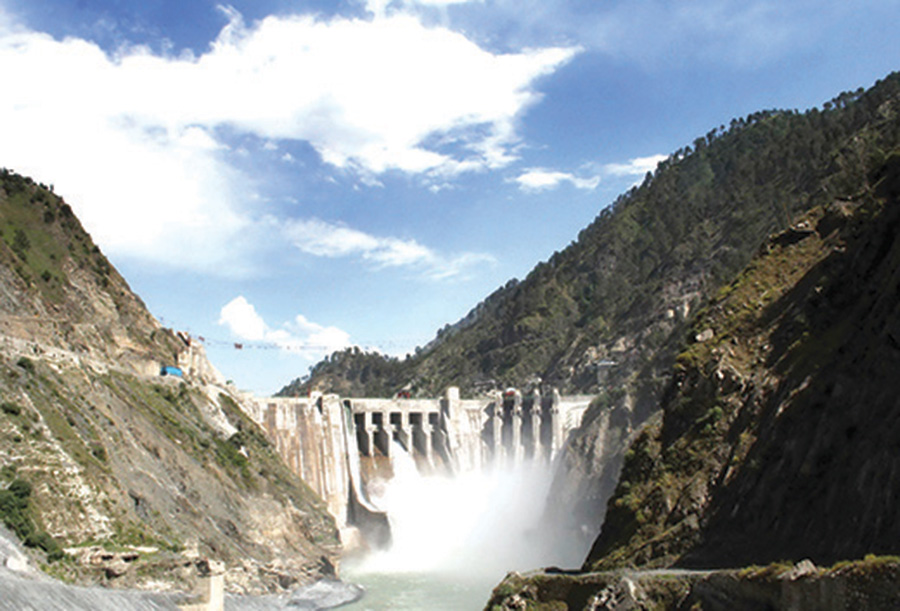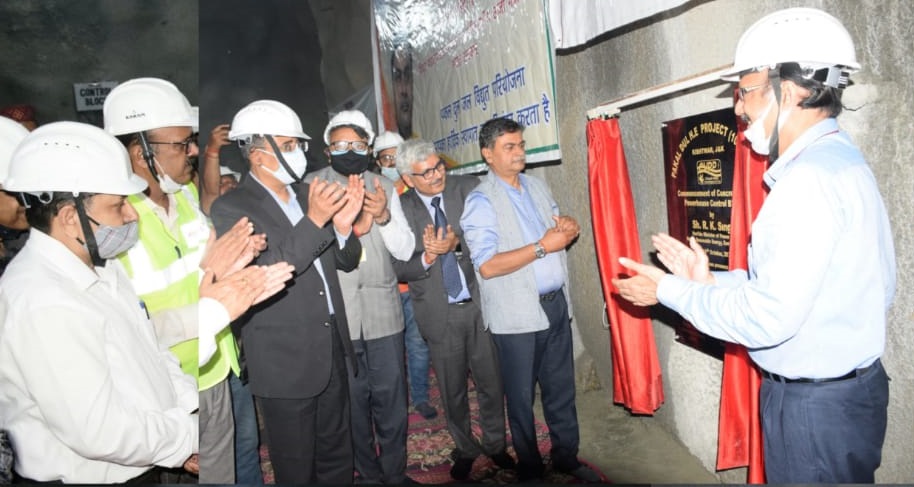With chilling nights getting darker in water-abundant Srinagar, due to the inadequate supply of energy and massive load shedding, the politicians have raked up the old debate about where the energy produced in Jammu and Kashmir goes. Masood Hussain explains the basics of generation and consumption

At a time when water-abundant Jammu and Kashmir is facing a crippling energy crisis and the discharge in water bodies has gone down to an all-time low, the public debate is back to the fundamental question: How much energy Jammu and Kashmir produce? Where it is consumed? Which part of the generation has the first right to use in Jammu and Kashmir?
In 2022-23, the last financial fiscal that ended March 31, 2023, Jammu and Kashmir consumed less energy than it produced. Available data suggest that the overall generation of energy in Jammu and Kashmir last year was 29931 million units and the consumption within the erstwhile state was of the order of 20,206 million units. This generation is from all sources including power generation companies in which Jammu and Kashmir has no or little ownership. Even though the energy is generated in Jammu and Kashmir, it is not entirely required to be consumed here. This forces the power utilities in Jammu and Kashmir to purchase the deficit energy from different companies to manage its demand or at least part of it.
Key Players
In Jammu and Kashmir, there are two major players in the energy generation. The Government of India-owned National Hydroelectric Power Corporation (NHPC) of India is the major player. In Jammu and Kashmir, it operates eight major power generation stations, are the major earning stations of the company. Cumulatively, these stations produced 24740 million units of energy in 2022-23. This generation makes up 49 per cent of the overall power that the NHPC generated from all its operations across India in the year. In 2021-22, operations in Jammu and Kashmir contributed slightly more than 50 per cent of NHPC’s overall generations. In 2014-15, more than 55 per cent of the energy generated by NHPC was coming from Jammu and Kashmir.
Jammu and Kashmir State Power Development Corporation (JKSPDC) is the second major player in energy generation in Jammu and Kashmir. Till the two-phase 900-MW Baglihar came into being, the JKSPDC would run a chain of small hydropower projects spread across Ladakh, Kashmir and Jammu. Right now, it owns 13 hydroelectric projects excluding the Baglihar. Available data suggests that in 2022-23, the total energy that the JKSPDC projects were to the tune of 5191.65 million units of which 2712.30 million units were generated by the twin-phase Baglihar project.
Off late, the NHPC and JKSPDC have entered into a series of agreements aimed at implementing some major power projects. However, all those Joint Venture-implemented projects are at various stages of implementation and not in operation. It will take some more time till the first one of them is completed and gets into production.
Energy Ownership
In Jammu and Kashmir, the entire generation of the JKSPDC is for the exclusive consumption of power utilities. Part of the Baglihar generation, however, is being sold to repay the debt that was raised for implementing the project.
NHPC pays 12.5 per cent of its energy generation as part of the royalty to Jammu and Kashmir on all its projects for using the water resource. For the rest of it, Jammu and Kashmir has the first right of purchase on some part of the energy as other states have also their allocations.
In 690-MW Salal, the first NHPC project that launched the corporation and which is producing the cheapest hydropower in India, Jammu and Kashmir has an allocation of 34.39 per cent, which is 237 MW of the installed capacity.
In 480-MW Uri-I, Jammu and Kashmir’s allocation is 163-MW, which is 33.96 per cent of the overall generation. The 240-MW, Uri-2 that operates downstream near Slamabad, Jammu and Kashmir’s allocation is 20.33 per cent, which is 49 MWs.

At Kishtwar, where 390-MW DulHasti operates, Jammu and Kashmir has allocated entitlement over 21.15 per cent, which is 82 MWs. In 120-MW Sewa-2, Jammu and Kashmir’s share is 19.17 per cent, which is 23 MW.
In Gurez, where the 330-MW Kishanganga operates, the host state has an allocation of 13 per cent, which is 43 MWs.
In certain projects, Jammu and Kashmir has unallocated entitlement as well. It includes 36 MWs of Uri-II, 40 MW of Dulhasti, 12 MW of Sewa-II and 34 MW of Kishanganga.
The rest of the generation is shared by various other states, which have the first right. These rights are decided at the conception of a power generation project. In the various JVs that JKSPDC and Jammu and Kashmir government inked in the last many years, a clause has been inserted that gives the host state the first right to purchase over part of the generation and also the first right to refuse over the rest of it. This will show up once these projects, mostly controversial, will get into generation in the next five to 10 years.
Other Entitlement
Available data suggests that from the cumulative installed capacity of 47201 MWs in more than 60 projects across the country, Jammu and Kashmir has a total entitlement of 2834 MWs, which includes 1713 MWs of allocated share and 1121 MWs of unallocated entitlement. It includes 100 MW unallocated entitlement that Jammu and Kashmir got by a special order of the Prime Minister on July 9, 2013.
However, this means that Jammu and Kashmir can withdraw the entire share of allocations at a pre-decided cost (periodically regulated by the energy commissions). In case, it may not be required, it can sell it to parties it wishes. This has been a standard practice in Jammu and Kashmir that during peak summers when the water discharge in Jammu and Kashmir’s water bodies is at an optimum level, the government would direct the energy to more energy deficit areas and use the same energy during winters purely as barter.

The engineers in Jammu and Kashmir have evolved a mechanism for adequate water harvesting. In water bodies reporting low discharge during winter, they would collect the discharge for the whole day and use the water for generation during peak hours. This practice is now in vogue at various places outside Jammu and Kashmir.
Despite all this, the deficit remains. To manage this, the Jammu and Kashmir Power Trading Corporation Limited goes to the open market for purchasing energy. In the last few years when energy became a commodity that can be traded at exchanges, the costs fluctuated on minute to minute basis. This has added to the load on the power utilities and the consumers. Since the utilities have to supply power at a fixed tariff, as decided by the power regulatory bodies, they, sometimes have to bear losses for keeping the show on.
It is worth mentioning here that Srinagar and Jammu city are the main power consumption spots across Jammu and Kashmir. Massive dependence on electricity for almost everything makes the twin cities the major consumers, unlike the periphery where traditional systems are still in vogue. Thumb rule is the energy consumption in Jammu and Kashmir sees almost an average ten per cent increase every year, which adds to the deficit given the sluggish pace with which the new generation is added. Power projects are very capital-intensive areas and have long gestation periods.
Massive Losses
The massive gap between the demand and supply is keeping the power utilities always on tenterhooks, especially during winter. The official response is that the sector is suffering massive losses as the power supplied is not getting properly paid. In 2022-23, an unconfirmed report suggests that Jammu and Kashmir purchased electricity from various power makers worth Rs 8689 crore but the power tariff collections remained at around Rs 3608 crore. This essentially means that the losses were at Rs 4852 crore. To fund these losses, the administration has to either raise loans or divert allocations from other sectors. In the last five years, the Jammu and Kashmir government raised more than Rs 31,000 crore in loans to pay for the outstanding energy purchase.
Earlier, the losses were seen as Transmission and Distribution (T&D) losses. Now, it is being calculated as Aggregate Technical and Commercial (AT&C) power losses, which include various factors including transformation and distribution losses, poor conductors, theft and poor tariff recovery. Interestingly, Jammu and Kashmir sits at the top of AT&C losses in India with more than 50 per cent against the national average of 19.73 per cent.
There are various factors responsible for the massive losses. A run-down power distribution system has been a serious crisis for the power utility. Off late, in high consumption areas, it has improved and now in theft-prone areas, ABC is being used to prevent unauthorised withdrawal of energy. The flat rate system has been changed and now smart meters are being used, which help the supplier keep an exact account of the supply and consumption.
Right now, when Kashmir is reeling under a serious power crisis, the Kashmir Power Distribution Corporation Ltd (KPDCL) has launched a serious initiative to locate the innovatively illegal system of power consumption. The officials of the company move from area to area and locate how an absolute minority of the consumers are using new methods of stealing power. Though this process was already on, the new element is that the officials are naming and shaming these consumers and imposing fines on the spot. Reports appearing in the media suggest that almost eight crore rupees of fines were imposed and recovered in the ongoing campaign, this season, so far.
Will these initiatives somehow result in a better supply of power to Jammu and Kashmir, remains to be seen.
The post Jammu Kashmir Energy Generation 2022-23 appeared first on Kashmir Life.
from Kashmir Life https://ift.tt/giCYw2Z
via IFTTThttps://ift.tt/fo76Vrx
No comments:
Post a Comment